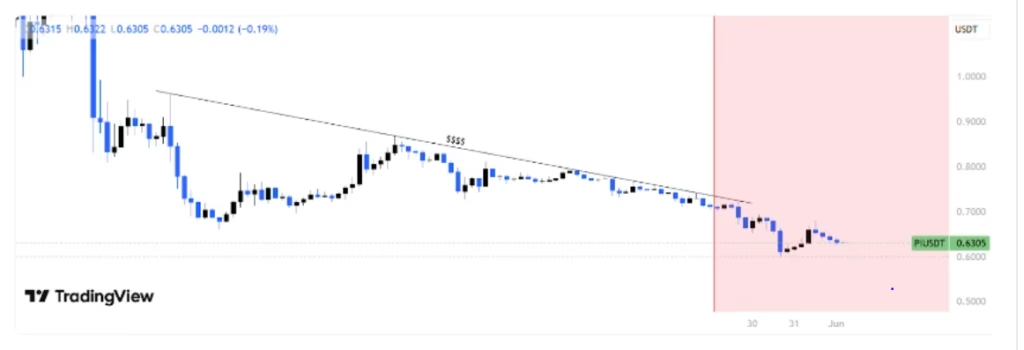- Pi Network Coin is testing a key support near $0.62 and risks dropping to $0.40 if it fails.
- A short-term recovery is possible, but long-term gains depend on improved utility and exchange listings.
The Pi Network Coin price is at a critical crossroads this June. After weeks of declining sentiment and ongoing community frustration, Pi Coin is testing a key support zone near $0.62. This level may determine whether the digital asset plunges further or stages a meaningful recovery.
ALSO READ:35 Million Users and Counting: What’s Next for Pi Network?
Bearish Signals Surround Key Support
Recently, Pi Coin dipped to about $0.60 before a slight bounce back to $0.628. Technical indicators, however, remain mostly bearish. The MACD shows a bearish crossover, and the price stays trapped inside a descending channel. The 50-period exponential moving average (EMA), once a support, now acts as strong resistance near $0.72.

Analyst Dr. Altcoin warns that if Pi fails to hold the $0.605 support, a sharp 40% drop to around $0.40 could happen by August. The stakes are high as the coin must hold its ground and break above the bearish trendline resistance to reverse the current downtrend.
Token Unlocks Amplify Selling Pressure
Adding to the pressure, over 274 million Pi tokens are scheduled to unlock in June, worth roughly $169 million at current prices. This influx could increase selling volume at a fragile time. The Pi Foundation controls an enormous supply of tokens spread across thousands of wallets, raising concerns about centralization and deterring major exchanges like Binance and Coinbase from listing Pi Coin.
Community Sentiment Wanes Amid Transparency Concerns
Frustration is growing within the Pi community due to perceived lack of transparency from the project’s founders. Many users demand clearer updates on the mainnet development, real-world use cases, and exchange listings. While recent gaming-related ecosystem updates were introduced, they have done little to restore investor confidence.
Possible Short-Term Rebound
Despite the bearish outlook, a short-term bounce remains possible if Pi Coin holds the $0.605–$0.628 support zone and forms bullish reversal patterns. Some technical signals like the RSI rebounding from oversold territory and a green MACD histogram suggest potential stabilization.
For a sustained recovery, Pi needs to break above $0.72 with strong volume. Otherwise, downward pressure may persist.
Year-End Outlook: Cautious Optimism
Looking ahead, analysts foresee a potential rebound in the latter half of 2025, especially after token unlocks slow post-August. Some projections place Pi Coin near $2.75 by December, provided the project improves utility and gains exchange support.
June as a Make-or-Break Month
June stands as a make-or-break moment for Pi Network Coin. Holding the $0.60 support and breaking above resistance could trigger a recovery. Failure may push prices toward $0.40, further eroding trust.
As the community waits for clearer technical signals and more utility, volatility is likely to continue dominating Pi Coin’s price action. Investors should exercise caution and watch for key developments before committing.
Pi Network remains a fascinating project with a massive user base, but its price outlook depends heavily on June’s critical market movements and ongoing progress in utility.
MIGHT ALSO LIKE:XRP Price Analysis June 2025: Rebound or More Downside Ahead?
DISCLAIMER:
The views and opinions expressed herein are solely those of the author and do not necessarily reflect the views of the publisher. The publisher does not endorse or guarantee the accuracy of any information presented in this article. Readers are encouraged to conduct further research and consult additional sources before making any decisions based on the content provided.